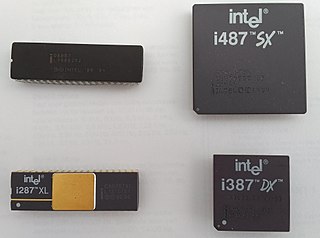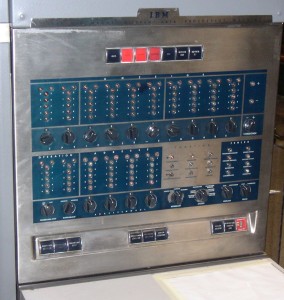Related Research Articles

In computing and electronic systems, binary-coded decimal (BCD) is a class of binary encodings of decimal numbers where each digit is represented by a fixed number of bits, usually four or eight. Sometimes, special bit patterns are used for a sign or other indications.

In computing, floating-point arithmetic (FP) is arithmetic using formulaic representation of real numbers as an approximation to support a trade-off between range and precision. For this reason, floating-point computation is often used in systems with very small and very large real numbers that require fast processing times. In general, a floating-point number is represented approximately with a fixed number of significant digits and scaled using an exponent in some fixed base; the base for the scaling is normally two, ten, or sixteen. A number that can be represented exactly is of the following form:
MIPS is a family of reduced instruction set computer (RISC) instruction set architectures (ISA) developed by MIPS Computer Systems, now MIPS Technologies, based in the United States.

A floating-point unit is a part of a computer system specially designed to carry out operations on floating-point numbers. Typical operations are addition, subtraction, multiplication, division, and square root. Some FPUs can also perform various transcendental functions such as exponential or trigonometric calculations, but the accuracy can be very low, so that some systems prefer to compute these functions in software.
Double-precision floating-point format is a computer number format, usually occupying 64 bits in computer memory; it represents a wide dynamic range of numeric values by using a floating radix point.
A ternary numeral system has three as its base. Analogous to a bit, a ternary digit is a trit. One trit is equivalent to log2 3 bits of information.

The IBM 700/7000 series is a series of large-scale (mainframe) computer systems that were made by IBM through the 1950s and early 1960s. The series includes several different, incompatible processor architectures. The 700s use vacuum-tube logic and were made obsolete by the introduction of the transistorized 7000s. The 7000s, in turn, were eventually replaced with System/360, which was announced in 1964. However the 360/65, the first 360 powerful enough to replace 7000s, did not become available until November 1965. Early problems with OS/360 and the high cost of converting software kept many 7000s in service for years afterward.
In computing, binary translation is a form of binary recompilation where sequences of instructions are translated from a source instruction set to the target instruction set. In some cases such as instruction set simulation, the target instruction set may be the same as the source instruction set, providing testing and debugging features such as instruction trace, conditional breakpoints and hot spot detection.
In logic, a three-valued logic is any of several many-valued logic systems in which there are three truth values indicating true, false and some indeterminate third value. This is contrasted with the more commonly known bivalent logics which provide only for true and false.
Setun was a computer developed in 1958 at Moscow State University. It was built under the leadership of Sergei Sobolev and Nikolay Brusentsov. It was the most modern ternary computer, using the balanced ternary numeral system and three-valued ternary logic instead of the two-valued binary logic prevalent in other computers.

Content-addressable memory (CAM) is a special type of computer memory used in certain very-high-speed searching applications. It is also known as associative memory or associative storage and compares input search data against a table of stored data, and returns the address of matching data.
Balanced ternary is a ternary numeral system that uses a balanced signed-digit representation of the integers in which the digits have the values −1, 0, and 1. This stands in contrast to the standard (unbalanced) ternary system, in which digits have values 0, 1 and 2. The balanced ternary system can represent all integers without using a separate minus sign; the value of the leading non-zero digit of a number has the sign of the number itself. The balanced ternary system is an example of a non-standard positional numeral system. It was used in some early computers and also in some solutions of balance puzzles.
The IEEE Standard for Floating-Point Arithmetic is a technical standard for floating-point arithmetic established in 1985 by the Institute of Electrical and Electronics Engineers (IEEE). The standard addressed many problems found in the diverse floating-point implementations that made them difficult to use reliably and portably. Many hardware floating-point units use the IEEE 754 standard.
In computing, fixed-point refers to a method of representing fractional (non-integer) numbers by storing a fixed number of digits of their fractional part. Dollar amounts, for example, are often stored with exactly two fractional digits, representing the cents. More generally, the term may refer to representing fractional values as integer multiples of some fixed small unit, e.g. a fractional amount of hours as an integer multiple of ten-minute intervals. Fixed-point number representation is often contrasted to the more complicated and computationally demanding floating-point representation.
In computer programming, operators are constructs defined within programming languages which behave generally like functions, but which differ syntactically or semantically.
In computing, a word is the natural unit of data used by a particular processor design. A word is a fixed-sized datum handled as a unit by the instruction set or the hardware of the processor. The number of bits or digits in a word is an important characteristic of any specific processor design or computer architecture.
A ternary computer, also called trinary computer, is one that uses ternary logic instead of the more common binary system in its calculations. This means it uses trits instead of bits, as most computers do.

Decimal computers are computers which can represent numbers and addresses in decimal as well as providing instructions to operate on those numbers and addresses directly in decimal, without conversion to a pure binary representation. Some also had a variable wordlength, which enabled operations on numbers with a large number of digits.
In computing and telecommunications, a unit of information is the capacity of some standard data storage system or communication channel, used to measure the capacities of other systems and channels. In information theory, units of information are also used to measure information contained in messages and the entropy of random variables.

In computing, an emulator is hardware or software that enables one computer system to behave like another computer system. An emulator typically enables the host system to run software or use peripheral devices designed for the guest system. Emulation refers to the ability of a computer program in an electronic device to emulate another program or device.
References
- ^ DSSP & Forth : Compare And Analysis
- G. Frieder, A. Fong, and C. Y. Chao. A Balanced Ternary Computer. Department of Computer Science, State University of New York at Buffalo, pages 68–88, 1972
- Ternary computers: part I: motivation for ternary computers G. Frieder, 1972; Proceeding MICRO 5 Conference
- Ternary computers: part 2: emulation of a ternary computer G. Frieder, 1972; Proceeding MICRO 5 Conference